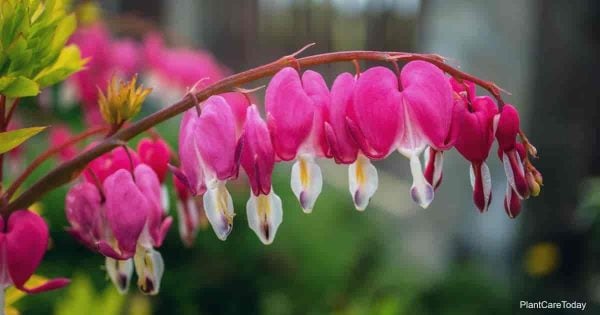The Bleeding Heart Plant or Dicentra spectabilis (dy-SEN-truh, speck-TAB-ih-liss) is a pretty herbaceous perennial plant native to Japan, Korea, Siberia, and China.
It is a popular plant in colder areas of the United States because it can tolerate harsh winters and make a colorful and welcoming comeback early in the springtime, year after year.

However, it prefers the morning sun with afternoon shade, partial shade to full shade locations.
How Can You Recognize Bleeding Heart Plants?

You may experience some confusion as to exactly what a Bleeding Heart Plant is because it goes by several other common names, including:
- Dutchman’s Breeches
- Butterfly Banner
- Kitten Breeches
- White Eardrops
- Soldier’s Cap
- Steer’s Head
- Dicentra
This plant grows about 10′ to 15′ feet tall in its natural habitat but may grow only about 3′ to 7′ feet tall as a container plant.
You’ll recognize this plant by its heart-shaped pink, fuchsia, white blossoms, and attractive green leaves that grow in a basal rosette.

Remember, recognizing this plant is important because all parts of this plant can present a hazard to your dog, cat, and children if ingested.
Additionally, these plants are toxic to horses and livestock because of the isoquinoline alkaloids they contain.
What Parts Of The Plant Are Poisonous Or Toxic?
Bleeding heart plants contain isoquinoline alkaloids, making them poisonous plants to humans and animals.
All parts of the plant are toxic when ingested. Touching or handling the plant may also cause skin irritation.
It is probably best to treat the Bleeding Heart as you would poison oak or sumac?

What Symptoms Does Bleeding Heart Plant Poisoning Cause?

Animals or people who ingest Bleeding Heart Plants may experience these toxic effects, including:
- Respiratory problems
- Loss of coordination
- Sudden clumsiness
- Sudden lethargy
- Dermatitis
- Weakness
- Diarrhea
- Vomiting
- Drooling
- Seizures
- Tremors
- Skin rash
Luckily, this is not an especially tasty plant, and ingesting much (or any) of it is unlikely.

Even so, it is wise to know the early symptoms and keep an eye out for them because, if left untreated, isoquinoline alkaloid toxicity can lead to harmful effects like kidney and liver damage.
Even a small amount of these substances can lead to serious complications, so if you believe your pet has eaten Bleeding Heart Plant, offer water right away and observe carefully.
If you see any symptoms, call your vet.

If you believe your child has ingested the plant, see your pediatrician.
Of course, prevention is preferable to treatment, so the wisest course of action is to keep animals and children away from this plant altogether.
When you are visiting an unfamiliar yard or park, be sure to look around and identify Bleeding Heart Plants and any other potentially toxic plants before allowing your kids or pets to run free.
How To Protect Yourself While Handling The Bleeding Heart Plant
Although there are no specific warnings associated with handling this plant, it only makes sense to wear gloves, eye protection, and long sleeves when pruning and planting Bleeding Heart Plant.

Contact with the sap could cause irritation.
Furthermore, you can’t go wrong if you avoid burning this plant or breathing the resulting fumes.
